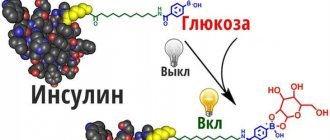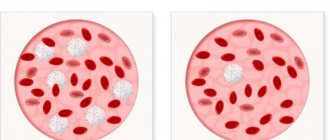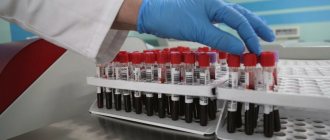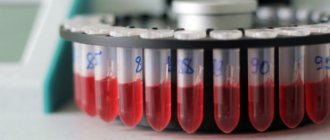Urea is the end product of protein breakdown, which is produced by the liver and, after being filtered by the kidneys, is excreted in the urine. A decrease in its level in the blood can be observed as a consequence of various physiological and pathological processes in the human body. The symptoms in this case will not be pronounced, so you can suspect a low level of urea only by certain indirect signs.
Reduced urea content in test results
The value of urea directly depends on the degree of functioning of the kidneys, liver and, of course, on the age category of the patients. The following parameters indicate a small amount of a chemical compound in the blood:
| Age | Indicators of urea deficiency (mmol/l) |
| Up to 1–1.5 months | <1,5 |
| From 2 months to 14 years | <1,4 |
| 15–60 years | <2.0 (for women) and <2.6 (for men) |
| 60+ | <2,4 |
In the final forms of hematology studies, you can often see numbers slightly different from the values given above. This is primarily due to the fact that each specialized laboratory, due to the peculiarities of diagnostics, has different normal limits. Since in people after 60–62 years of age, the organs of the urinary system most often work in a different mode (filtration of substances slows down), their urea concentration mainly increases rather than decreases.
Minor fluctuations do not always indicate pathologies, so do not panic when you see different urea values. But in this case, it is still necessary to visit your doctor. To determine the urea content in serum, a so-called biochemical analysis is prescribed, which requires venous blood.
Substance standards
Each age and condition has its own urea index, in addition, it can change in accordance with the reagents. Moreover, in the female body a much smaller amount of urea is considered normal than in male patients. To determine the concentration of urea, blood is taken from a vein in the elbow. However, before the study it is necessary to follow certain rules. For example, you should not eat in the evening, the analysis should be carried out on an empty stomach, and drinking water is allowed.
Typically, a urea test is carried out in conjunction with a creatinine test. If the patient has any pathologies, this can easily be revealed in the tests. The lower threshold of normal urea for women of childbearing age is considered to be 2.5 mmol/l. The maximum normal level of urea is considered to be 6.4 mmol/l.
Normal levels of urea in the blood can only occur if the liver processes ammonia at the same speed as the kidney structures remove unnecessary components and toxic substances from the body. These speeds must be completely consistent with each other. If the results show a urea content higher than normal, then this indicates serious problems in the functionality of the renal structures; if the levels are low, there is reason to suspect problems in the liver.
Symptoms of carbamide deficiency
Basically, at the initial stage of the deviation, accompanied by a decrease in carbonic acid diamide in the body, practically no characteristic signs appear. In a certain proportion of people, slow protein breakdown occurs due to the following symptoms:
- frequent urination;
- flatulence, observed mainly after eating;
- chronic fatigue;
- weakening of muscles;
- lack of appetite;
- tingling sensation in the right hypochondrium near the kidney;
- heaviness and nagging pain in the lumbar region;
- belching with bitterness.
If a patient exhibits a decrease in body mass index that is not associated with self-regulation of weight through diets, then there is a high probability of insufficient urea levels in the blood.
Swelling, most often observed in the lower legs, can also signal a urea deficiency, which develops due to a malfunction of the kidneys
Another clear sign indicating problems with carbamide production is nausea, which makes itself felt mainly after a meal. Moreover, the presence of such a symptom has nothing to do with the diet itself, for example, with an incorrect ratio of organic substances in the products consumed or an excess of junk food. This disease can be detected even when leading a healthy lifestyle.
What if there is too much urea?
If the level of urea in the blood increases noticeably, this certainly indicates the development of serious pathological abnormalities. The most serious causes of this phenomenon are considered to be pathologies that accelerate protein decomposition and provoke pathological abnormalities in organic structures such as prostate adenoma or bladder tumor, endocrine pathologies or acute kidney failure.
Also, an increased content of urea is found in severe burns, severe infectious lesions, myocardial failure and leukemia, bleeding or intestinal obstruction. If an increase in urea accompanies any pathology, then we are talking about uricemia or uremic syndrome.
So, urea is a secondary metabolic product that has no metabolic significance. They are transported through the bloodstream into the kidney tissue and then into the urine. At the same time, urea levels in the blood help specialists correctly assess the functions of the kidney, liver and muscle structures. If the levels are lower in pregnant women, then this is quite normal, but in healthy people, a decrease in urea indicates liver pathologies, and an increase indicates kidney disease.
What diseases reduce urea levels?
The following diseases can be pathological causes of low urea in the blood:
What is uric acid responsible for in the blood?
- hypothyroidism (low levels of the main thyroid hormone);
- liver failure;
- helminthiasis (parasitic infection);
- chronic pancreatitis (inflammation of the pancreas);
- cirrhosis of any form;
- hepatocellular carcinoma (liver cancer);
- hepatitis;
- hepatic encephalopathy;
- parenchymal jaundice;
- fatty hepatosis (pathological proliferation of lipids in liver cells);
- acromegaly (excessive production of pituitary growth hormone, leading to disproportionate enlargement of various parts of the body);
- liver hemangioma (benign formation affecting the vessels of the largest gland);
- malabsorption in the gastrointestinal tract;
- congenital deficiency of enzymes responsible for normal urea synthesis.
A decrease in urea in the blood is also observed when liver cells are negatively affected by certain poisons: arsenic, phosphorus or carbon tetrachloride.
After undergoing planned surgery, especially those involving the kidneys, liver, and lower intestines, carbamide levels also drop in some patients. An insufficient level of carbonic acid diamide may be associated with overhydration - that is, excess water content in the body, resulting from an imbalance of water-salt balance.
Abuse of alcoholic beverages entails severe destruction of liver cells and, as a result, urea deficiency
Normal values
In order to determine the concentration of urea in the blood, a biochemical analysis is performed. For this purpose, a small amount of venous blood is taken.
This study is carried out both in a regular women's clinic, but also in a private laboratory. The therapist must decipher the results obtained. If necessary, the doctor can refer the patient for additional studies.
During different periods of pregnancy, the concentration of urea varies:
- In the very first weeks from the moment of conception until the end of the first half of pregnancy, this figure is 2.5-7.1 mmol/l.
- In the third trimester of pregnancy, the concentration changes to 2.5-6.3 mmol/l.
When is a deficiency of a substance not a health risk?
Active sports on a regular basis are sometimes reflected in the results of the study, in which even a healthy person will show a decrease in urea levels. If the patient adheres to any strict diet for a long time, implying an almost complete absence of protein in the diet, then the lack of urea will again make itself felt.
This also includes the complete exclusion of protein foods as part of vegetarianism or veganism. An unhealthy diet with a predominance of harmful products in the vast majority of cases entails an imbalance of substances synthesized in the body, including urea.
There is an increased likelihood of detecting a deficiency when prescribing hemodialysis - blood purification using a special device: it is responsible for carrying out filtration, which for one reason or another can no longer be performed by the kidneys themselves. Referrals for such a procedure are given mainly to people with chronic renal failure, since this diagnosis can significantly prolong the patient’s life.
Blood tests in diabetics who regularly inject insulin may show insufficient levels of carbamide.
The use of diuretics, as well as hypoglycemic and hypoammonemic drugs, often provoke a decrease in urea levels. And also drugs that lower this compound in the blood include hormonal agents (testosterone, somatotropin, estrogen) and chitosan - a complex sugar obtained from the shells of crustaceans (lobsters, crayfish and crabs).
The latter is a natural carbohydrate component, which is quite often included in dietary supplements (biologically active substances). Drinking excess water often leads to a deficiency of urea in both the blood and urine. This condition does not need to be treated using special medical methods; usually the body returns to normal immediately after the volume of fluid entering it decreases.
Sometimes doctors administer nutrients to patients in hospitals with distilled (sterile) water parenterally, that is, bypassing the gastrointestinal tract (gastrointestinal tract) - usually through the use of an IV. In this case, after a hematological analysis, a lack of urea will again be detected.
Urea concept
Experts classify carbamide (urea) as a substance formed as a result of protein breakdown, and the structure of urea contains residual nitrogenous components. Urea is formed in the process of protein metabolism, which occurs in several rather complex stages of decomposition, transformations and transformations. At one stage, ammonia is formed, which itself is a dangerous toxin for the body. In the liver structures, it breaks down into several substances, one of which is urea. Normally, this urea is usually sent to the kidney, from where it is excreted along with urine. Therefore, the concentration of urine in the blood and urine is greatly influenced by the condition of the kidneys.
Why does urea content decrease during pregnancy?
While waiting for the birth of a child, the female body literally functions for two, ensuring the correct development of the baby without compromising the health of the expectant mother. During gestation, a woman’s protein structures are produced more intensively, but their breakdown is extremely slow in order to save money. Therefore, a decrease in urea levels is diagnosed.
If a urea deficiency is detected, a pregnant woman should not lose sight of this fact, since in some cases it still indicates certain health problems
Proteins are rightfully considered the most valuable organic substance, which is also a unique building material that is actively used in the formation of a new organism. Its gradual consumption guarantees a more balanced process of physiological development of the child in the womb.
How to normalize low carbamide levels
During pregnancy, first of all, you will need to undergo additional studies to find out the main reasons for the decrease in parameters.
Drug therapy is used when diseases are detected that provoke a decrease in normal values. It is extremely rare to observe a decrease in urea due to the development of diseases. The main factor is always malnutrition and metabolic disorders. Therefore, treatment most often consists of prescribing a diet where meat, fish and dairy dishes will predominate.
Urea deficiency in children and adolescents
The first week of a newborn’s life is characterized by a noticeable increase in urea levels, then its content can sharply decrease even to 1.0–1.2 mmol/l. A deficiency of this kind occurs before the age of 1 year, since it is during this period that the baby undergoes the most active growth and development.
Muscle and bone structures “absorb” the largest part of the proteins coming from food, but their breakdown is carried out as economically as possible. In the active phase of adolescence (13–15 years), a decrease in urea concentration may also be observed, associated with the same formation of the muscular system, which occurs quite dynamically.
Why and how to carry out analysis to measure urea concentration
The necessary presence of proteins for the process of cell formation is the reason for the constant presence of urea in the human body. As a result of their synthesis, ammonia is formed, which is subsequently converted by the liver into urea, which goes to the kidneys through the bloodstream.
The norms for this substance in the blood differ depending on the patient’s belonging to a certain age group:
- Newborns – 1.5-5.3 mmol/l;
- Child under 14 years of age – 1.7-6.4 mmol/l;
- Women under 60 years old – 2.3-6.3 mmol/l, and men – 3.3-7.3 mmol/l;;
- People 60 and older – 2.7-7.7 mmol/l.
A test for urea levels in the blood is carried out to determine the normal functioning of the liver, kidneys and muscular system. Based on the results of this study, the doctor can tell whether there is sufficient removal of harmful substances from the body.
A biochemical blood test is taken from a vein no earlier than 8 hours after eating any food. It is permissible to drink only water as a liquid before visiting the laboratory.
Under no circumstances should you decipher the results yourself, as the conclusions you draw may turn out to be incorrect and will negatively affect your well-being.
Causes of low carbamide levels in the blood
Among the natural factors causing a decrease in this indicator, the following physiological processes in the human body can be identified:
- inability of the kidneys to concentrate urine due to aging. Observed in men and women after 60 years of age;
- during pregnancy, a girl can consume a large amount of liquid, and there is also an intensive consumption of protein for fetal growth;
- The human diet contains a very small amount of protein products or allows for their complete absence (vegetarianism).
Low urea can be observed due to therapeutic procedures:
- hemodialysis, which purifies the blood through an artificial kidney;
- intravenous administration of fluid causes hyperhydration in the body, i.e. the amount of water in it increases greatly.
The main diseases characterized by low urea in a blood test:
- kidney diseases occurring with increased proteinuria, hypoalbuminemia and hypoproteinemia. This condition is called nephrotic syndrome (kidney failure);
- inflammatory processes in the gastrointestinal tract, their chronic forms;
- liver diseases (cholelithiasis, pancreatitis, cirrhosis, hepatitis of various etiologies, necrosis);
- congenital deficiency of enzymes necessary for protein synthesis;
- the presence of helminthic infestations in the liver and intestines;
- complications arising after surgical operations in the gastrointestinal tract;
- chronic course of pancreatic pathologies;
- malignant tumors;
- hormonal abnormalities due to thyroid dysfunction (hypothyroidism);
- poisoning with arsenic, carbon tetrachloride or phosphorus and, as a consequence, the onset of liver failure;
- malabsorption syndrome, in which poor absorption of amino acids by the intestinal walls occurs;
- acromegaly - dysfunction of the anterior pituitary gland;
- fatty degeneration is a chronic, non-inflammatory liver disease.
The use of hormones such as somatotropin, testosterone, as well as insulin injections can cause a decrease in urea.
Any of the reasons needs to be confirmed through specific examinations. If you are sure that the decrease in the level is caused by natural factors, then you need to inform your doctor about this and follow his recommendations for normalizing urea levels.
Symptoms
A low concentration of urea in the blood cannot be considered as a separate symptom by which a diagnosis can be made; the patient is prescribed a test for the indicator if there are signs of a pathological nature:
- regular bloating, accompanied by painful sensations (the person has not previously experienced flatulence);
- belching that tastes bitter;
- unreasonable lack of desire to eat or its decrease;
- a feeling of heaviness and pressure in the right side, in the hypochondrium;
- weight loss with normal nutrition;
- nausea after eating food;
- discomfort in the liver or kidneys;
- swelling of the limbs or other parts of the human body;
- persistent muscle weakness;
- feelings of fatigue or weakness that negatively affect performance.
The manifestation of symptoms requires a person to check the state of health of the body; failure to consult a doctor in a timely manner threatens the development of complications. To do this, you need to make an appointment with a specialist who will prescribe research, establish a diagnosis and treatment appropriate to the pathological problem.
Decrease in urea levels in childhood
Low concentrations of protein breakdown products in the blood of a small child do not require treatment procedures if they are not accompanied by the manifestation of the above symptoms.
This process is normal and is observed due to accelerated growth and metabolism in their body.
In this case, the child is not in danger, but if he has elevated bilirubin, then this is a clear sign of the development of a pathological process that requires immediate medical attention.
In children of the older age group, low urea levels may indicate pathologies associated with impaired functionality of the liver, kidneys or intestines, as well as an increase in the synthesis of growth hormone.
In this case, it is necessary to establish as quickly as possible the cause that caused this problem, and, following the doctor’s recommendations, eliminate it by taking certain medications and following the necessary protein diet.
What to do if there is a low concentration of urea in the blood
After your analysis reveals a deviation from the normal level of carbamide, the necessary examinations are prescribed, the cause is determined and medications are selected that will help solve the problem. Their action should be aimed at:
- restoration of the functional abilities of affected organs;
- ridding the body of toxic substances formed during protein breakdown;
- normalization of the level of enzymes of the gastrointestinal tract and the amount of urea in the blood.
For any physiological conditions, as well as the presence of pathological processes accompanied by this problem, the doctor necessarily recommends the use of protein products:
- meat;
- milk;
- cottage cheese;
- fish;
- eggs;
- nuts;
- pasta;
- boiled sausage;
- millet;
- buckwheat and oatmeal;
- cheese;
- rye and wheat bread;
- pearl barley;
- rice;
- potato;
- parsley;
- salads and other dishes including beans, peas, broccoli, kohlrabi, cauliflower.
When following a diet, you must remember that the daily protein requirement for a child under 14 years of age is 1.5-1.7 grams. per 1 kg of his body weight. At an older age, it is important for a person to consume 1.7-2.5 grams. protein per 1 kg of weight.
According to medical statistics, the problem is less common in patients than detecting the level of carbamide in the blood. To avoid symptoms, especially for pregnant women and children, it is necessary to enrich the diet with protein foods in the required amount.
If any of the pathologies are diagnosed, consult a doctor for a blood test to recognize the problem and begin its treatment.
Symptoms of decline
If the level of urea in the blood drops sharply, a person experiences the following symptoms:
- excess gas appears in the intestines, it swells and hurts;
- appetite worsens;
- bitter belching occurs;
- discomfort and heaviness in the projection of the liver (in the hypochondrium on the right);
- muscle weakness;
- weight loss;
- pain in the lumbar region;
- the distal areas of the legs and arms swell;
- asthenia, constant fatigue and inability to perform usual work.
If similar signs appear, you should start listening to yourself more carefully. Before a person sees a doctor, he should record suspicious symptoms in a notebook or, for example, in the memory of a mobile phone - it is always at hand.
The level of urea is determined by a biochemical blood test. At the same time, the creatinine concentration is determined to identify renal pathologies, and liver tests are also performed. The final diagnosis is made based on a combination of complaints, objective examination data, medical history and test results.











